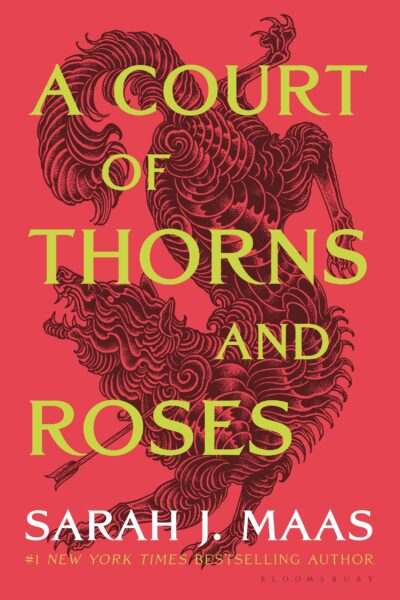A Court of Thorns and Roses
Chapter 35
by Maas, Sarah J.Feyre awakens in a dark, damp prison cell, disoriented and in severe pain. Her face is badly injured, with a broken nose, swollen eyes, and a split lip. The oppressive atmosphere of the dungeon, combined with the distant sounds of screaming, heightens her fear. Despite her agony, she forces herself to assess her injuries and maintain composure, determined to survive whatever Amarantha has planned. The chapter vividly captures her physical suffering and psychological resilience as she grapples with her dire circumstances.
As Feyre struggles to stay calm, she reflects on her decision to return to the faerie realm, defying Alis’s warnings. She recalls seeing Tamlin beside Amarantha, which fueled her resolve to confront the High Queen, even at great personal risk. Her thoughts shift to Clare, a human whose suffering weighs heavily on her conscience, reinforcing her belief that she deserves punishment. The distant crack of a whip and screams remind her of the brutal fate that may await her, yet she clings to the hope of redeeming herself and saving Tamlin.
Lucien unexpectedly enters her cell, shocked by her presence and injuries. He chastises her for returning, revealing that Tamlin had sacrificed much to ensure her safety. Feyre defiantly insists she had no choice, driven by love and the need to break Amarantha’s curse. Lucien reluctantly agrees to help, using his limited magic to heal her broken nose and reduce the swelling, though he leaves bruises to avoid suspicion. Their tense exchange underscores the stakes of Feyre’s mission and the loyalty between them.
The chapter concludes with Lucien explaining Amarantha’s hold over the High Lords, including Tamlin, who remains defiant. Feyre learns that all are trapped Under the Mountain until her trials—and likely her death—conclude. The mention of Jurian’s eye, now a grotesque ring worn by Amarantha, reinforces the queen’s cruelty. Despite the grim outlook, Feyre’s determination persists, setting the stage for her impending ordeal. The chapter blends physical torment, emotional conflict, and political intrigue, deepening the narrative tension.
FAQs
1. What physical and emotional state is Feyre in when she first regains consciousness in the cell?
Answer:
Feyre awakens in severe physical distress, with a broken nose, split lip, swollen eyes, and overall facial trauma that causes excruciating pain. The damp, moldy cell exacerbates her discomfort, and the distant screams of another prisoner heighten her fear. Emotionally, she battles panic and guilt—particularly over Clare’s suffering—but forces herself to remain composed. Despite her agony, she methodically assesses her injuries and strategizes survival, demonstrating her resilience. Her determination to “make it right” for past mistakes and her focus on Tamlin (“I had to tell him I love him”) reveal her emotional drive amid the horror.2. How does Lucien’s arrival impact Feyre’s situation, and what does their interaction reveal about their relationship?
Answer:
Lucien provides critical aid, healing Feyre’s nose and reducing her swelling (though leaving bruises to avoid suspicion). Their exchange is tense—he chastises her for coming, calling her “foolish,” but his relief at finding her alive and his immediate help underscore their deep bond. His sarcasm (“pert and pretty”) and Feyre’s trust in him (allowing him to set her nose despite pain) reflect their friendship’s complexity: combative yet loyal. Lucien’s revelation about Amarantha restoring a fraction of his power also advances the plot, hinting at broader political manipulations.3. Analyze the significance of Feyre’s guilt over Clare’s suffering. How does this connect to her motivations in this chapter?
Answer:
Feyre’s guilt over Clare—a human victim of faerie cruelty—shapes her acceptance of punishment (“I deserved this”). This guilt humanizes her and contrasts with Amarantha’s sadism, emphasizing Feyre’s moral compass. It also fuels her resolve to endure trials and “make it right,” tying her personal redemption to her love for Tamlin. The juxtaposition of Clare’s screams and Feyre’s determination highlights her transformation from a survivalist to a self-sacrificing protagonist, willing to face horror for others’ sake.4. What does Lucien’s disclosure about Amarantha’s control over the High Lords suggest about the political dynamics Under the Mountain?
Answer:
Lucien reveals Amarantha has summoned all High Lords and trapped them until Feyre’s trials conclude, showcasing her absolute dominance. By restoring fragments of Lucien’s power as manipulation (“to entice Tamlin”), Amarantha weaponizes autonomy. This reflects her broader strategy: using divided loyalties and fear to maintain control. The forced attendance of even “obedient” High Lords implies no one is exempt from her games, setting the stage for a larger conflict between her tyranny and potential rebellion.5. How does Sarah J. Maas use sensory details to immerse readers in Feyre’s experience in the dungeon?
Answer:
Maas employs visceral sensory imagery to amplify Feyre’s suffering. Sound (“dripping water,” “screaming”), taste (“coppery blood”), smell (“mold,” “mildew”), and tactile pain (“hay jabbed my cheek”) create a claustrophobic, agonizing atmosphere. The torchlight’s “slants” and the whip’s “crack” punctuate the dread. These details ground Feyre’s disorientation and pain, making her resilience more striking. The sensory overload also mirrors her emotional turmoil, immersing readers in her perspective and heightening the chapter’s tension.
Quotes
1. “I couldn’t panic. No, I had to keep my tears in check, had to keep my wits together. I had to survey the damage as best I could, then figure out what to do.”
This quote captures Feyre’s resilience and strategic thinking even in extreme physical pain and psychological distress. It shows her transition from victim to active problem-solver in the dungeon, setting the tone for her survival mentality throughout the chapter.
2. “I just … I had to tell him that I love him. To see if it wasn’t too late.”
This emotional confession reveals Feyre’s core motivation for returning to danger - her love for Tamlin. It’s a pivotal moment that explains her seemingly reckless actions and underscores the theme of sacrifice for love that runs through the series.
3. “She’s summoned all the High Lords to her now—and even those who swore obedience are now forbidden to leave until … until your trials are over.”
This quote reveals the broader political stakes and Amarantha’s absolute control over the fae world. The hesitation before “until your trials are over” ominously implies the deadly nature of Feyre’s upcoming challenges while expanding the scope of the conflict beyond just Tamlin’s curse.
4. “I knew some good would come of being down here.”
Lucien’s sardonic remark provides a moment of dark humor while subtly showing his loyalty to Feyre despite his earlier scolding. It represents the complex relationships between characters and how they find small victories even in dire circumstances.
Quotes
1. “I couldn’t panic. No, I had to keep my tears in check, had to keep my wits together. I had to survey the damage as best I could, then figure out what to do.”
This quote captures Feyre’s resilience and strategic thinking even in extreme physical pain and psychological distress. It shows her transition from victim to active problem-solver in the dungeon, setting the tone for her survival mentality throughout the chapter.
2. “I just … I had to tell him that I love him. To see if it wasn’t too late.”
This emotional confession reveals Feyre’s core motivation for returning to danger - her love for Tamlin. It’s a pivotal moment that explains her seemingly reckless actions and underscores the theme of sacrifice for love that runs through the series.
3. “She’s summoned all the High Lords to her now — and even those who swore obedience are now forbidden to leave until … until your trials are over.”
This quote reveals the broader political stakes and Amarantha’s absolute control over the fae world. The hesitation before “until your trials are over” ominously implies the deadly nature of Feyre’s upcoming challenges while expanding the scope of the conflict beyond just Tamlin’s curse.
4. “I knew some good would come of being down here.”
Lucien’s sardonic remark provides a moment of dark humor while subtly showing his loyalty to Feyre despite his earlier scolding. It represents the complex relationships between characters and how they find small victories even in dire circumstances.
FAQs
1. What physical and emotional state is Feyre in when she first regains consciousness in the cell?
Answer:
Feyre awakens in severe physical distress, with a broken nose, split lip, swollen eyes, and overall facial trauma that causes excruciating pain. The damp, moldy cell exacerbates her discomfort, and the distant screams of another prisoner heighten her fear. Emotionally, she battles panic and guilt—particularly over Clare’s suffering—but forces herself to remain composed. Despite her agony, she methodically assesses her injuries and strategizes survival, demonstrating her resilience. Her determination to “make it right” for past mistakes and her focus on Tamlin (“I had to tell him I love him”) reveal her emotional drive amid the horror.
2. How does Lucien’s arrival impact Feyre’s situation, and what does their interaction reveal about their relationship?
Answer:
Lucien provides critical aid, healing Feyre’s nose and reducing her swelling (though leaving bruises to avoid suspicion). Their exchange is tense—he chastises her for coming, calling her “foolish,” but his relief at finding her alive and his immediate help underscore their deep bond. His sarcasm (“pert and pretty”) and Feyre’s trust in him (allowing him to set her nose despite pain) reflect their friendship’s complexity: combative yet loyal. Lucien’s revelation about Amarantha restoring a fraction of his power also advances the plot, hinting at broader political manipulations.
3. Analyze the significance of Feyre’s guilt over Clare’s suffering. How does this connect to her motivations in this chapter?
Answer:
Feyre’s guilt over Clare—a human victim of faerie cruelty—shapes her acceptance of punishment (“I deserved this”). This guilt humanizes her and contrasts with Amarantha’s sadism, emphasizing Feyre’s moral compass. It also fuels her resolve to endure trials and “make it right,” tying her personal redemption to her love for Tamlin. The juxtaposition of Clare’s screams and Feyre’s determination highlights her transformation from a survivalist to a self-sacrificing protagonist, willing to face horror for others’ sake.
4. What does Lucien’s disclosure about Amarantha’s control over the High Lords suggest about the political dynamics Under the Mountain?
Answer:
Lucien reveals Amarantha has summoned all High Lords and trapped them until Feyre’s trials conclude, showcasing her absolute dominance. By restoring fragments of Lucien’s power as manipulation (“to entice Tamlin”), Amarantha weaponizes autonomy. This reflects her broader strategy: using divided loyalties and fear to maintain control. The forced attendance of even “obedient” High Lords implies no one is exempt from her games, setting the stage for a larger conflict between her tyranny and potential rebellion.
5. How does Sarah J. Maas use sensory details to immerse readers in Feyre’s experience in the dungeon?
Answer:
Maas employs visceral sensory imagery to amplify Feyre’s suffering. Sound (“dripping water,” “screaming”), taste (“coppery blood”), smell (“mold,” “mildew”), and tactile pain (“hay jabbed my cheek”) create a claustrophobic, agonizing atmosphere. The torchlight’s “slants” and the whip’s “crack” punctuate the dread. These details ground Feyre’s disorientation and pain, making her resilience more striking. The sensory overload also mirrors her emotional turmoil, immersing readers in her perspective and heightening the chapter’s tension.



0 Comments